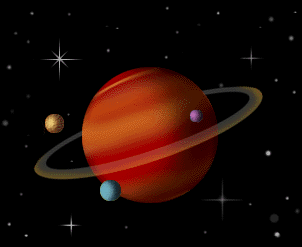There are eight planets in the solar system.
The planets orbit (travel around) the Sun.
The time a planet takes to complete one orbit is called a year.
Some of the planets have moons that orbit around them.
Each planet spins on its axis. Imagine a stick going through the Earth from pole to pole. This is the axis. Each planet rotates, or spins, around its axis. The time it takes to complete one rotation is one day.
Information about the planets in their order from the sun
Mercury
- Diameter (kms): 4,850
- Kms from the sun: 58,000,000
- Time to orbit sun: 88 days
- 1 Rotation(length of a day): 58 days, 16 hours
- No of Moons: 0
NOTES: Dry, extremely hot. Surface full of craters. To astronomers in Ancient Greece this planet was known as Apollo when seen in the morning, and Hermes when seen in the evening. The planet was later named Mercury after the Roman messenger God. The American spacecraft, Mariner 10, flew by the planet three times in 1974 and 1975. About 45 percent of the surface has been mapped.
Venus
- Diameter (kms): 12,100
- Kms from the sun: 108,000,000
- Time to orbit sun: 225 days
- 1 Rotation (length of a day): 243 days
- No of Moons : 0
NOTES: Surrounded by orange clouds of poisonous gas the planet is a burning desert environment. Ancient Greek astronomers called this planet Hesperus when it was seen in the morning, and Phosphorus when seen in the evening. The Romans named it Venus after the goddess of love.
Earth
- Diameter(kms): 12,750
- Kms from the sun: 150,000,000
- Time to orbit sun: 365 days
- 1 Rotation (length of a day): 23 hours, 56 minutes
- No of Moons : 1
NOTES: The only known inhabited planet, believed to be about 4000 million years old.
Mars
- Diameter(kms): 6,880
- Kms from the sun: 228,000,000
- Time to orbit sun: 687 days
- 1 Rotation (length of a day): 24 hours, 37 minutes
- No of Moons: 2
NOTES: Known as the Red Planet, surface is a cold desert. Has no oceans. Has same land area as Earth. Mars is named after the Roman god of war. Its two moons are named after the horses, said to pull the god's chariot, Phobos and Deimos.
Jupiter
- Diameter(kms): 143,000
- Kms from the sun: 778,000,000
- Time to orbit sun: 12 years
- 1 Rotation (length of a day): 9 hours, 50 minutes
- No of Moons: 67
NOTES: Largest planet in our solar system. Consists of gas & liquid. Has a ring around it too dark to be seen from Earth. Astronomers in Ancient Rome named the planet after the ruler of all Roman gods. Jupiter's rings were discovered by the Voyager-1 space probe in 1979. The four largest moons are Io, Europa, Ganymede and Callisto.
Saturn
- Diameter(kms): 120,000
- Kms from the sun: 1,425,000,000
- Time to orbit sun: 30 years
- 1 Rotation (length of a day): 10 hours, 14 minutes
- No of Moons: 62
NOTES: Saturn has 18 named satellites plus 12 recently discovered and as yet unnamed ones. The largest of its satellites (moons) is called Titan.Tethys (named after a Greek sea goddess) and Dione (a daughter of Zeus) Mimas, and Enceladus (son of the god Titan) are the names of four of Saturn's other moons. The planet was named in the 6th century after the Roman god of agriculture. First observed with a telescope by Galileo in 1610.
Uranus
- Diameter(kms): 51,000
- Kms from the sun: 2,687,000,000
- Time to orbit sun: 84 years
- 1 Rotation (length of a day): 20 hours ( approx)
- No of Moons: 27
NOTES: Surrounded by clouds of blue green gas. Has 10 rings made up of dust particles. Tilts at angle, probably because of comet crashing into it. The rings adjusted their orbit and travel over and under instead of around equator. This planet was discovered by Sir william Herschell in 1781. The first of the rings were discovered in 1977.
Neptune
- Diameter(kms): 50,000
- Kms from the sun: 4,495,000,000
- Time to orbit sun: 165 years
- 1 Rotation (length of a day): 21 hours (approx)
- No of Moons: 13
NOTES: Powder blue colour, has 5 rings and at least 8 moons. Ancient astronomers calculated that there must be a planet exisiting in that place and the Romans named it after their god of the sea. It wasn't actually discovered until 1846. Voyager 2, an unmanned robot space probe photographed the five rings surrounding Neptune in 1989.
UPDATE August 2006: On August 24, 2006, the International Astronomical Union (IAU) redefined the term "planet". Because Pluto is smaller than some of the moons in our solar system and because it has an unusual orbit it is no longer recognised as one of the planets in the solar system
Want to remember the names and the order of the planets?
This mnemonic device is one way to help you remember the names of the planets in order from the Sun. It uses the first letters of the planet names in a phrase.
My Very Excellent Mother Just Served Us Nachos:
Mercury Venus Earth Mars Jupiter Saturn Uranus Neptune











